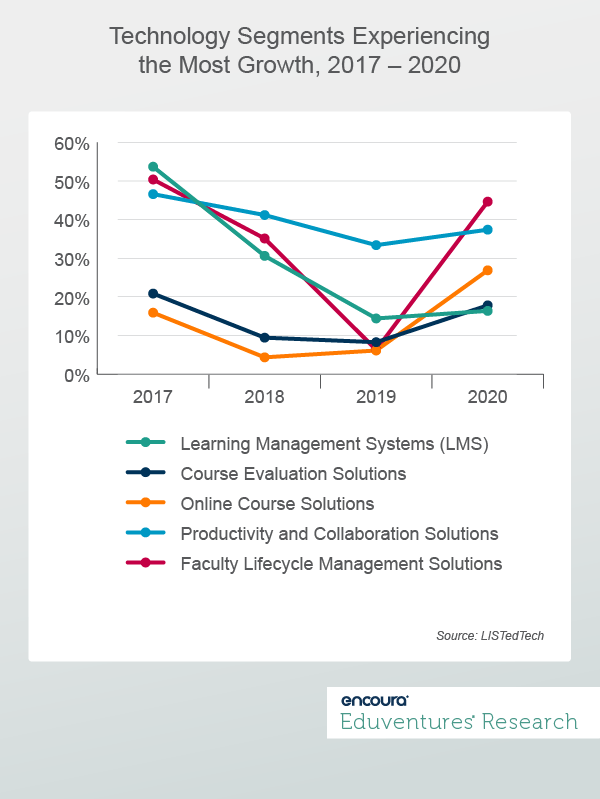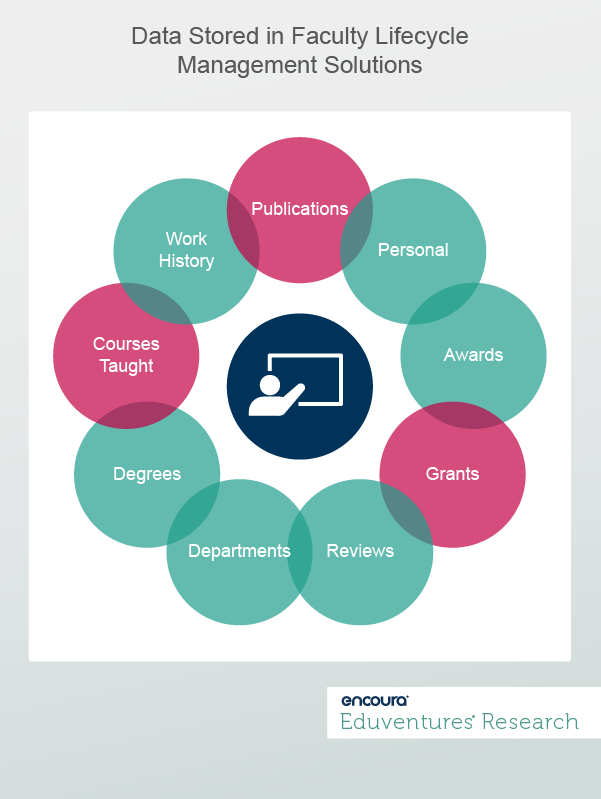There has been a great deal of discussion about the impact of COVID-19 on technology adoption among colleges and universities. Many commentators, for example, have noticed the spike in the adoption of Productivity and Collaboration Solutions (like Zoom) and have attributed this to institutional efforts to deliver remote learning.
But looking at implementation data across different market segments also reveals a surprising spike in adopting an often-overlooked technology segment: Faculty Lifecycle Management Solutions. Our data shows annual growth of 44% for this segment—seven percentage points more than Productivity and Collaboration Solutions.
[inlinetweet prefix="RT @EduventuresInc:" tweeter="" suffix="#EVWakeUpCall"]
Why would technology that seems disconnected from a pandemic response have such a growth spurt during the pandemic?
[/inlinetweet]
What is a Faculty Lifecycle Management System?
Before unpacking this trend, we should first understand what Faculty Lifecycle Management Solutions do. All institutions track student-level data to get insight into things like courses taken or assessments completed. Many, however, do not have access to similar insight into faculty activities, like courses taught or assessments administered.
The Faculty Lifecycle Management Solutions segment comprises solutions that help provide this insight. Interfolio’s Faculty Information System or Watermark’s Digital Measures, for example, allow institutions to collect, store, track, analyze, and report faculty-level teaching and research data.
Drawn from implementation data, Figure 1 highlights the five segments—Faculty Lifecycle Management Solutions, Online Course Solutions, Learning Management Systems, Productivity and Collaboration Solutions, and Course Evaluation Solutions—that have experienced the most growth among the segments we tracked since last year and have increased their growth from the previous year.

It should not be surprising that four of the five segments experienced growth between 2019 and 2020, as they obviously relate to institutional efforts to deliver remote learning during COVID-19. For example, Productivity and Collaboration Solutions implementations grew by 37% during that time, and Online Course Solutions and Course Evaluation Solutions increased by 27% and 18%, respectively.
Faculty Lifecycle Management Solutions, however, exhibited the most growth between 2019 and 2020, with an annual growth of 44%. Likewise, implementations of these solutions had the sharpest increase in growth from the previous year, with a 38% difference in annual growth from 2018 - 2019. In contrast, although Productivity and Collaboration Solutions experienced high growth between 2019 and 2020, this growth was only 4% greater than the growth between 2018 - 2019 (33%).
How Might We Explain Growth?
A closer look at the data tracked within Faculty Lifecycle Management Solutions shows the intersection between the growth in this segment and institutional responses to COVID-19. As shown in Figure 2, these solutions capture nine primary types of information related to faculty activities: publications, personal information (addresses, etc.), awards, grants received, reviews and evaluations, departmental assignments, degrees obtained, courses taught, and work history. Many institutions require that faculty members use these data sets to report and track their activities each year, usually as a Faculty Activity Report (FAR), which they submit to their supervisors annually for review.

Our research shows that institutional responses to COVID-19 have affected the data areas in red (above):
- Courses Taught. As institutions prepared for online learning in the spring of 2020, most institutional websites we reviewed (66%) focused on content intended to help prepare a faculty audience for remote learning. These featured descriptions of the logistics and solutions needed for remote teaching: operating video conferencing solutions, moving content to the learning management system (LMS), and how to use LMS assessment capabilities to deliver and review exams. It was one of many signs that, throughout the pandemic, many faculty members have had to exert a great deal of effort to get up to speed on remote teaching. This has meant that both faculty and institutions have had a greater need to deploy technology to share information about these efforts.
- Publications and Grants. In addition to demonstrating efforts for remote readiness, faculty may want to show how the pandemic has affected their teaching, research, and scholarships, areas important for promotion and tenure. But because they have devoted more energy and time to building remote education readiness, they have spent less time performing research and producing scholarship. As a result, many faculty needed a way to explain the overall impact COVID-19 has had on their academic careers and, in many cases, explain why they have not performed the scholarship or research expected of them. The University of Colorado at Boulder, for example, has used its Faculty Lifecycle Management Solutions to develop specific forms where faculty members can include their activities during the pandemic and explain how those activities affected their teaching, scholarship, or creative efforts.
In essence, the pandemic impacted the amount of preparation required of faculty to deliver courses and the amount of time available to further their academic careers. In response, many institutions turned to Faculty Lifecycle Management Solutions to allow their faculty members to record and share these impacts.
The Bottom Line
It may be straightforward to understand how institutional responses to the pandemic have affected specific segments that directly support areas most impacted by COVID-19—like proctoring or conferencing tools in the move toward remote learning. But this data and analysis also provide an example of just how wide-ranging the impact of institutional responses to COVID-19 has been on higher education technology.
Solutions like Faculty Lifecycle Management are more connected to these responses than we may have thought and signal how we should view the impact of the pandemic on the entire technology landscape. We may see in the future that other solutions, such as Financial Aid Processing Solutions, experience COVID-19-related growth due to how students negotiate tuition refunds and financial aid adjustments when continuing their educations or applying to colleges. Likewise, as institutions learn more about how COVID-19 has exposed gaps in their abilities to foster student engagement, leaders may leverage Constituent Relationship Management (CRM) Solutions to serves as the place where students can connect with institutions and learn more about academic support services.
Never Miss Your Wake-Up Call
Learn more about our team of expert research analysts here.
Eduventures Principal Analyst at Encoura
Contact
Over the past three years, Eduventures has developed a behaviorally and attitudinally-based market segmentation of college-bound high school students we call Student Mindsets™. This year, the sample of nearly 40,000 respondents was drawn from the myOptions® database of college-bound high school juniors and seniors as well as institutional inquiry lists, allowing us to refine and validate the Mindsets in a national sample of unprecedented breadth and depth.
These market “Mindsets” get at students’ imagined paths through college by assessing the desired outcomes of college, perceived importance of college experiences, and key decision criteria at time of application.
The fundamental purpose of the Eduventures Prospective Student Research is to help institutions better understand how college-bound high school students approach one of the most important decisions of their young lives. For a teenager, the college decision looms as a complex make-or-break moment, a pivotal turn on an imagined path to adulthood.
Thursday September 9, 2021 at 2PM ET/1PM CT
High school students are once again hopeful for a full-fledged traditional undergraduate college experience. While the pandemic caused many students to postpone their dreams of student life on campus, the upcoming year seems to be reigniting some of those hopes.
But what lingering effect will this past year’s experience have on the way current high school students approach their college choices? How can colleges and universities help students recover and reimagine what their college experiences might be going forward?
In this webinar, Eduventures Principal Analyst Kim Reid will reveal how high school students have entered their senior years this fall with significant shifts in their Student Mindsets™ about college. She will share how underserved students are changing their mindsets in unique ways from their peers, how to assess students’ expectations and goals as we come out of the pandemic, and how institutions can best reach and recruit prospective students given these notable shifts.

